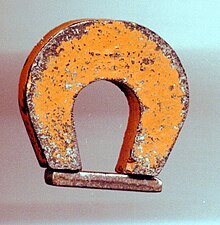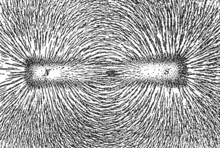Chumbak loha
Ek magnet (Greek μαγνήτις λίθος magnḗtis líthos, "Magnesian stone" se) ek material nai to object hae jon ki magnetic field produce kare hae. Ii magnetic field dekhae nai hae lekin ek magnet ke khaas property ke kaaran hae : ek force jin ki ferromagnetic materials, jaise kiiron ke attract kare hae, aur duusra magane ke repel kare hae.



References
badloAur parrho
badlo- "positive pole n". The Concise Oxford English Dictionary. Ed. Catherine Soanes and Angus Stevenson. Oxford University Press, 2004. Oxford Reference Online. Oxford University Press.
- Wayne M. Saslow, Electricity, Magnetism, and Light, Academic (2002). ISBN 0-12-619455-6. Chapter 9 discusses magnets and their magnetic fields using the concept of magnetic poles, but it also gives evidence that magnetic poles do not really exist in ordinary matter. Chapters 10 and 11, following what appears to be a 19th-century approach, use the pole concept to obtain the laws describing the magnetism of electric currents.
- Edward P. Furlani, Permanent Magnet and Electromechanical Devices: Materials, Analysis and Applications, Academic Press Series in Electromagnetism (2001). ISBN 0-12-269951-3.
Bahaari jorr
badlo- HyperPhysics E/M, good complete tree diagram of electromagnetic relationships with magnets
- Maxwell's Equations and some history
- Detailed Theory on Designing a Solenoid or a coil gun
- Video: The physicist Richard Feynman answers the question, Why do bar magnets attract or repel each other?
- Articles, tutorials and other educational information about magnets Archived 2008-10-07 at the Wayback Machine National High Magnetic Field Laboratory
- Answers to several questions from curious kids about magnets
- Magnetic units discussed Archived 2011-01-06 at the Wayback Machine
- EU requires warning on toys containing magnets
- Information on Permanent Magnets
- About Magnets Archived 2012-05-27 at the Wayback Machine
- International Magnetics Association Archived 2009-08-04 at the Wayback Machine
- Online magnetic pull force calculator